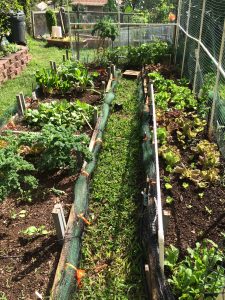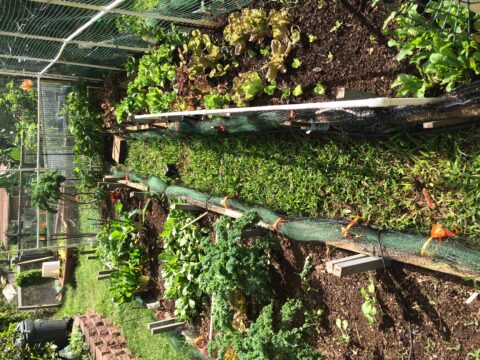Home grown food nourishes you
I used to think high-grade balsamic vinegar imported from Italy was the best there is. Then a friend gave me some superb banana vinegar he made by fermenting Haiku apple bananas. It’s even more flavorful than balsamic, plus has extra nutrients from the live probiotics that haven’t been killed by pasteurization or preservatives! Exotic is not always better and there are many ways home-grown, and made-nearby are better for you than anything produced in a far-away ecosystem.
When I moved here from the mainland, 25 years ago, I brought my mainland consumption patterns with me. They changed quickly because they don’t belong on an island in the middle of the Pacific[1]. I saw that things cost 25% more here simply to cover the cost of transportation and produce from the mainland was often wilted or manipulated to appear fresh when it isn’t.
Bigger is not necessarily better
Kmart was the first big box store to come to Maui. People lined up on the sidewalk outside days before it opened, excited to be the first inside. Then Walmart came, then Costco, and now Target. Many local businesses closed, unable to compete. With each closure of a small business, off-island mega-businesses got more of our local dollars and the cycle exacerbated. I miss Maui Garden Store and the mushroom farm in Haiku. We’ve traded that wise local gardening advice and those ono mushrooms for more plastic stuff made in China.

Our bodies are not designed to digest the food-like stuff that has been altered to last for months on shelves in the center of a modern grocery store. If a food “item” can survive a trip across the ocean, it’s not as fresh as produce from your garden or a farmer’s market. Processing replaces the volatile, nutritious parts of food (which bacteria and fungi also like to eat) with salt, sugar and chemicals that retard spoilage over long-distance transport and storage. This comes at the expense of nutrition, digestion and at high cost to our overall health.
Home Grown produce is the best!
Food spoils. You want to eat food that is grown nearby and is as fresh as possible. Our bodies evolved in harmony with the microbes in the soil, air, plants, and animals around us. Eating mostly-local is the story all humans lived until relatively recently. Even though some humans lived in urban centers where they could find exotic goods that traveled long distances by horse, camel, or boat, the majority of their food came from nearby and was prepared and eaten fresh, or preserved for the lean times. Modern agriculture produces a few crops for fast mass, ease of use, and transport-ability (e.g. russet potatoes grown to make trillions of french fries.) We can grow and eat more tasty and nutritious varieties at home – e.g. Okinawan purple, Yukon gold, All Blue – which are better-suited to overall human and planetary sustainability.
Because of our great weather, all of us in Hawaii can grow our own food, at least some of it. Another friend shares his homemade apple liquor with us; I make sauerkraut and share it around. If we manage our resources wisely and share with each other, we have plenty.
Go big picture
When you zoom out to see the big picture, local is clearly better. You might even be willing to forego the vast, ever-present variety of products from every part of the world when you see what it costs us and the planet[2]. As you shift your habits to fresh and local your preferences and body will realign. It doesn’t take long for your taste buds to prefer a tree-ripened local banana over an exotic one, picked excessively green, gassed to ripen artificially, and shipped thousands of miles[3].
The good news is that new, sustainably-focused farms and local business keep springing up like mushrooms. We need to support them by buying their products and voting for initiatives that support local production.
- Try coming to a Hawaii Farmer’s Union United meeting. The Haleakala chapter of HFUU meets at Haiku Community Center the last Tuesday of the month and the Mauna Kahalawai (West Maui) chapter at Maui Tropical Plantation the third Thursday of every month. Bring some food and share the sumptuous local potluck. hfuuhi.org
- Learn about the brilliant, innovative Farm to School program that’s replacing imported pseudo-food with fresh, local produce in our kids’ school lunches.
- Find resources to grow and share local products and be inspired by how much gets done when people communicate and cooperate at this grass-roots level. http://akitchengardeninkiheimaui.blogspot.com
It’s worth the time
Making my own food may take more time than heating up store-bought but it is more delicious, healthier, and satisfying on many levels beyond taste. I don’t overeat when I cook my own food. I decide the serving size and amount of salt in the soup I make and some of the nourishment comes from the process.
Wouldn’t it be great to grow right here, legumes, spices, and things that we now import? The food would be fresher and put important dollars back into local pockets. The trick is being willing to pay a little more now to support the shift in infrastructure and buying habits that will ultimately serve us for generations to come.
Gradual, continuous shifts of behavior create lasting change. Every week, decide to replace one off-island product with a locally-produced one. Make friends with someone who grows food, or ferments, or home-crafts. Let them inspire you to see what you can contribute to the local economy and then exchange what you produce.
Now more than ever, we need to support small mom and pop businesses here if they – and we – are to survive here. Exotic food and other products should not be most of what we consume and they are not necessarily better. The things we don’t produce here we need to consume lightly, in balance with nature and the seasons of production. Use local-made as your go-to and use exotic (aka imported) stuff sparingly.
Take back control of your eating, and overall consumption patterns. Support your local economy and your local (personal) ecosystem by eating and consuming local produce and products.
Notes:
*** This article first appeared in Living Aloha Magazine, July/August 2016. www.livingaloha.net
[1] It could be argued that those consumption patterns don’t belong anywhere anymore.
[2] Read Barbara Kingsolver’s book, High Tide in Tucson, written over the year she committed to consuming only what was produced within a few miles from where she lived, Tucson, AZ!
[3] My grown kids call those “bullshit bananas.”
If you liked this article, try this one about Gratitude for your food.
#buylocal #homegrown #sustainableeating #fresherisbetter

